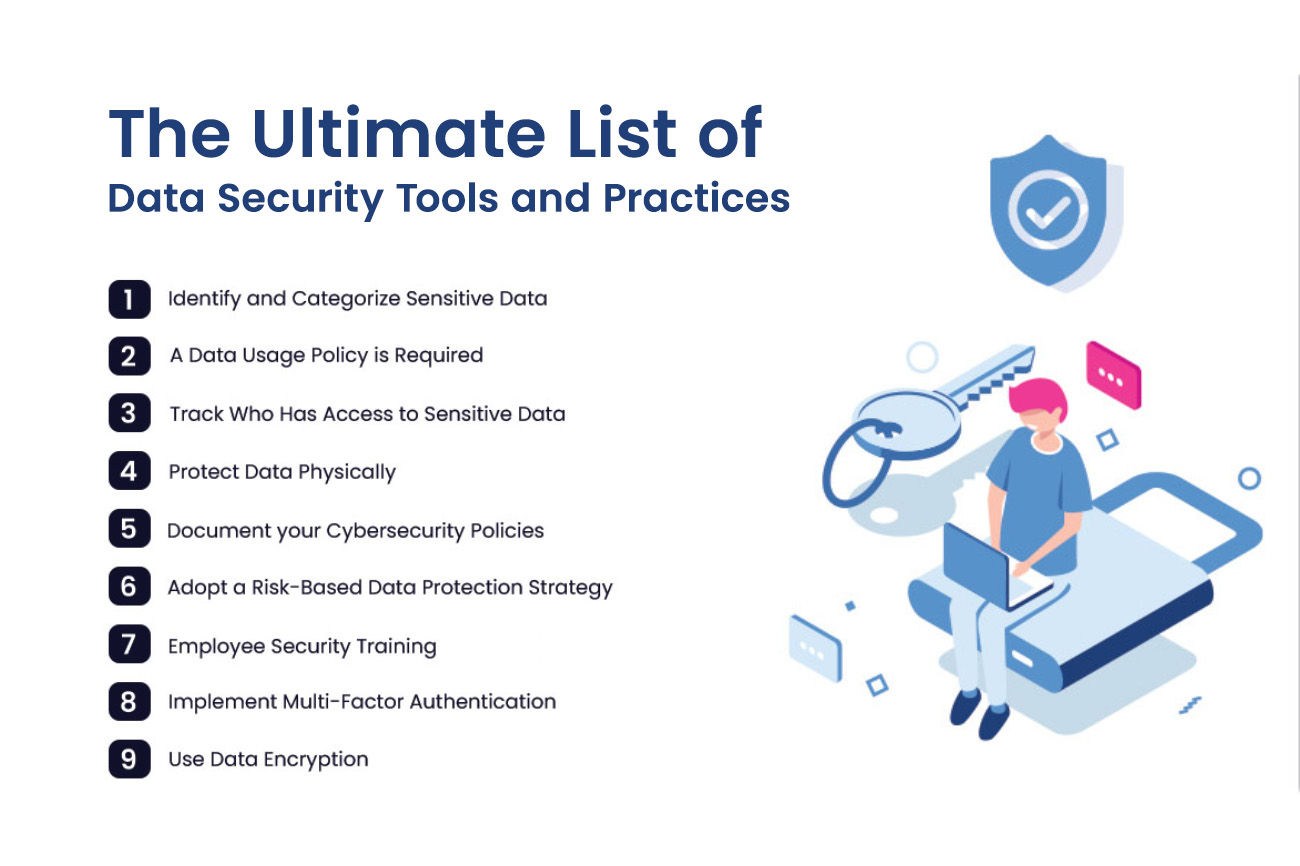
The Ultimate List of Data Security Tools and Practices
Today's digital world requires a deep understanding of data security, where the internet can also be helpful and risky for your data. Thus, people and businesses must use robust tools and methods to keep their data safe.
This guide will explain why data security is crucial, what tools you can use, and the best habits to keep your digital life safe. When you finish reading, you'll know how to protect your online information well.
-
What is Data Security?
Protecting your data is similar to locking away valuable possessions in a safe. Just as you wouldn't want anyone else to see or use your essential papers or valuable items without your permission, you also want to keep your sensitive digital information safe from unauthorized access, theft, or damage.
This could include personal details, passwords, financial information, or private data you don't want others to see. To protect your data, you use special techniques, like encryption and strong passwords, to keep it safe from hackers, viruses, or other threats on the internet.
-
Data Security Tools
-
Encryption Tools
Encryption tools are like special secret codes for your data. They mix up your information so only people with the correct key can unmix and understand it, protecting your data from snoops and hackers who might want to take it. So, use this solid lock of encryption tools to protect your sensitive information from online attackers.
-
Firewalls
Firewalls, whether in hardware form safeguarding entire networks or as software installed on individual devices such as computers or phones, act as digital security guards, shielding your digital assets from unwelcome intruders. Positioned between your trusted and untrusted networks (potential threats), they track every incoming and outgoing traffic and prevent anything dubious or unauthorized according to your predefined rules.
-
Intrusion Detection and Prevention Systems (IDPS)
IDPS are comprehensive data protection tools that oversee network and system operations. They promptly identify and react to possible security risks or policy breaches, utilizing various methods such as recognizing signatures, spotting anomalies, and analyzing behaviors. This approach instills confidence in organizations about IDPS's ability to pinpoint and prevent attacks from boosting security.
-
Access Control Systems
Access control systems manage who can access information by applying rules about how users can enter resources using passwords, security tokens, or biometrics. These systems help organizations safeguard critical data, prevent unauthorized access, and preserve their information's confidentiality and integrity.
-
Antivirus Software
Your computer is safe because of this protective shield called " Antivirus Software." This shield protects your computer from programs filled with viruses, malware, and spyware by scanning your system daily to detect and remove any potential threats. Moreover, antivirus software guarantees protection by continuously updating itself with the latest security protocols and defending against emerging threats.
-
-
Data Security Practices
-
Incident Response Plan
This data security practice involves preparing to respond quickly to security problems and limit harm. A good plan lists containment, investigation, mitigation, and incident communication steps. Organizations can quickly lower risks and keep sensitive data and assets safe by dealing with incidents promptly.
-
Employee Training
Employee training plays a crucial role in data security by focusing on the human factor. By conducting regular security awareness sessions, organizations educate employees about the latest threats, phishing attempts, and safe online behavior. This ultimately empowers the employees to recognize and handle potential risks, thereby reducing the chances of data breaches within the organization.
-
Regular Data Backups
Regular data backup aims to protect against data loss and minimize the chances of potential breaches or system failures. By consistently creating copies of essential data, organizations ensure that backups are readily accessible during emergencies. It is vital to conduct these backups regularly, preferably automated, and store them securely to avoid loss from physical damage or cyberattacks.
-
Patch Management
Patch management is crucial for maintaining software security. Organizations can address vulnerabilities that attackers may exploit by promptly applying patches, which helps prevent unauthorized access or data compromise. Proactive monitoring, testing, and automated solutions are essential for maintaining a secure IT environment, effectively protecting against constantly evolving cyber threats.
-
Multi-factor authentication (MFA)
MFA offers an upgraded level of security that goes beyond relying solely on passwords. Here, users must provide different verification types to access their accounts or systems, including a password and a special code sent to their mobile device or generated by an authentication app. This method greatly boosts security measures to discourage unauthorized access, even if someone has gotten hold of a user's password.
-
In conclusion, data security is a complex discipline that demands attentiveness, suitable tools, and a dedication to following best practices. By acquainting yourself with these concepts, you can make significant progress in establishing a secure digital environment.
Remember that the digital world mirrors the physical world in various aspects. Just as you wouldn't leave the front door of your home unlocked, it's crucial not to leave your data and digital assets unprotected. To create a safer digital environment, implement these data security tools and practices today. Remember, you should protect your data as a priceless treasure.
